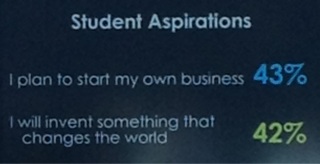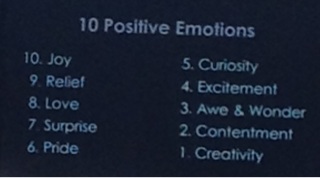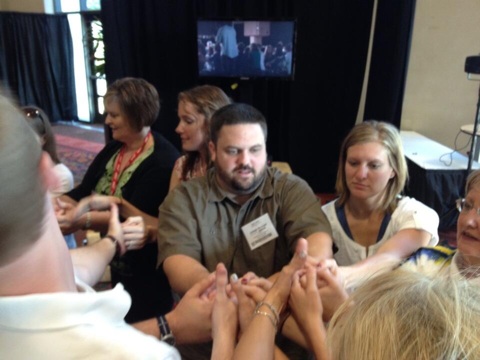I saw McGonigal's keynote last night, through the din of subdued Bogger Cafe murmurings. It was a fun presentation with lots of useful information, especially the statistics. But I was certain that the last time I saw her, McGonigal had a British accent. I'm old. Forgive me.
 One set of numbers that I thought were especially telling described student aspirations — that 43% of students want to start their own business and 42% plan to invent something that changes the world. Is it the job of formal education to support our children in these aspirations, or indoctrinate them with the harsh reality that they will work for someone else, follow instructions and fit in. I suspect that a lot of the products in the exhibit are designed for the latter.
One set of numbers that I thought were especially telling described student aspirations — that 43% of students want to start their own business and 42% plan to invent something that changes the world. Is it the job of formal education to support our children in these aspirations, or indoctrinate them with the harsh reality that they will work for someone else, follow instructions and fit in. I suspect that a lot of the products in the exhibit are designed for the latter.
 Another compelling part of the presentation was a listing of the 10 positive emotions that result from playing games. Although I am certain that there were many educators in the audience who needed to see that video games are not, necessarily, the root of all evi — I watched the keynote, wondering if Jane McGonigal was speaking to group of game designers, is this the presentation she would be giving? How playing games affects children is useful. But what would truly help me is understanding the mechanisms that evoke those emotions. How do games do it — and how might formal learning experiences pull those same triggers.
Another compelling part of the presentation was a listing of the 10 positive emotions that result from playing games. Although I am certain that there were many educators in the audience who needed to see that video games are not, necessarily, the root of all evi — I watched the keynote, wondering if Jane McGonigal was speaking to group of game designers, is this the presentation she would be giving? How playing games affects children is useful. But what would truly help me is understanding the mechanisms that evoke those emotions. How do games do it — and how might formal learning experiences pull those same triggers.
Of course, what was most fun was the MMTW, that is Massively Multiplayer Thumb Wrestling. I won't tell you how I did, but it might be my next book.


Hi…Jane McGonigal ,Iam Siddique Hussain.I have read your 5-6 posts in this blog,very excellent post by you.i like your “Refelections”posta and the positive , emotions aspirations are very important for every one’s life,Regards
education tulips
Hey David, You wrote, “But what would truly help me is understanding the mechanisms that evoke those emotions. How do games do it — and how might formal learning experiences pull those same triggers?” I believe that most teachers may not think to ask that question-but it’s really at the heart of what we need to understand if we’re going to apply good game design principles to our design and practice, so Bravo! The question is compelling and complex — depending on how deeply one may want to explore — but allow me to point you to some resources that have informed my understanding:
Amy Jo Kim (she refers to herself as an online community architect) has a number of talks on YouTube where she explains some of the approaches she and other game designers use to psychology and system thinking behind game design, and learn how to use game mechanics to create an experience that’s fun, compelling, and addictive (game designers don’t shy away from that term..which is a discussion unto itself, eh?) Start at 5.34 in this Google Talk she did— http://www.youtube.com/watch?v=ihUt-163gZI and http://www.eldergame.com/2009/08/reinforcement-concepts-for-designers/ is an exploration of one element: tedium (be sure to read the comments as well). John Hopsen wrote an article in 2001 that is still referenced in academic exploration of the neuroscience of game play http://www.gamasutra.com/view/feature/131494/behavioral_game_design.php?page=2 THat being said, in 2012 the author revisited the article and published: http://www.gamasutra.com/view/feature/172409/10_years_of_behavioral_game_design_.php
So the things you want to look into are operant conditioning, dopamine neurons, schedule of reinforcement, the Zeigarnik effect
and the “psychology of immersion
So far the book that explains it best has been Jesse Schell: The Art of Game Design http://www.amazon.com/books/dp/0123694965
@Peggy Sheehy, Thanks so much for your reply and for making these resources available through my blog. You and I have had a number of conversations about this topic, the mechanisms, and you have helped me so much with some of my presentations, one in particular, Cracking the Code of the ‘Native’ Information Experience.
As long as we believe no more than the face that games engage children, then we’ll keep thinking that integrating games will make them better students. It’s only in understanding what makes games so engaging that we will be able to retool formal education so that it not only engages but empowers students to become powerful learners.
Thanks again!
@Peggy Sheehy,
For what it’s worth, I wanted to offer the recommendation of Video Games and Learning, Teaching and Participatory Culture in the Digital Age by Kurt Squire and Gamification, A Simple Introduction and a Bit More by Andrzej Marczewski as two great reads on the principles of design and the psychology behind the motivation, the rewards, and achieving flow. As a predominate “right-brainer” and department chair I find this approach to learning long overdue.
@Kara DiCecco, Knowing Peggy, I am certainly that she has already read and possibly memorized both of these books. But I am very happy that you mention them here for my other readers.
Aaaaaaargh ! David – Fix my typos!!! lol
Yeah games are realy a study things nowadays. The students can learn more things from this games.for your valuable post thank you so much. You can visit my site for more information about that.
Hi David
Very interesting Blog, it made think deeply about the reasons that makes these teenage less care about inventing something that would change the world. kids these days are less concerned about the world itself. It is mainly related to what country are we talking about, what social level, and what financial level these children come from. It is their needs that define what do they want to do when they grow up.
From another side bringing up the idea of integrating the video games in education is very important. I am not talking about regular puzzle games, or cross words. No I am talking about the big deal, 2st century smart technology, ipads, tablets, electronic games that stimulates our senses. I believe they have made great impact on students education, as a high school biology teacher, I keep getting shocked by the knowledge my students receive from these games. Many them about the environment, animals, some of them playing virtual doctors, dentists, which help them learning a lot about human body and the science of life.